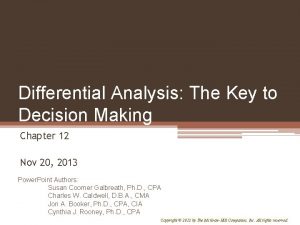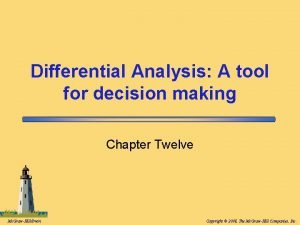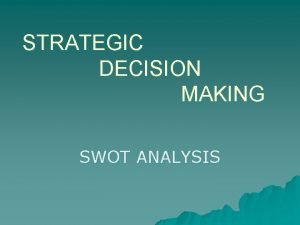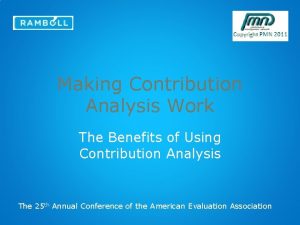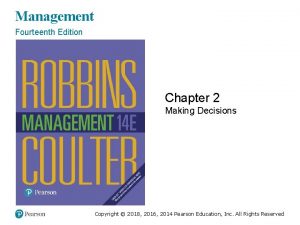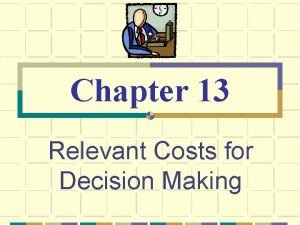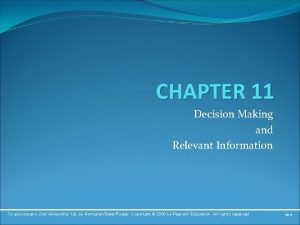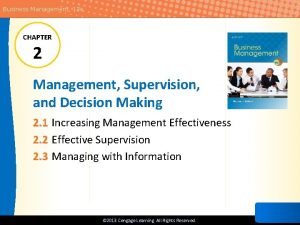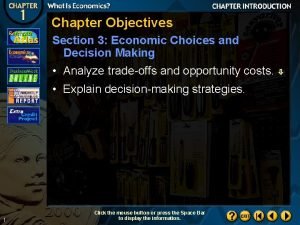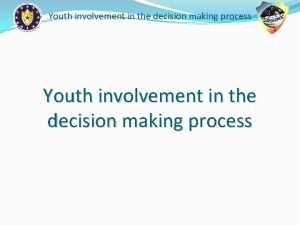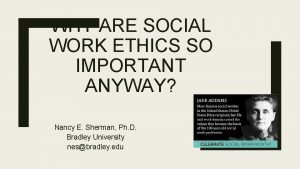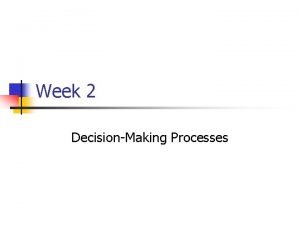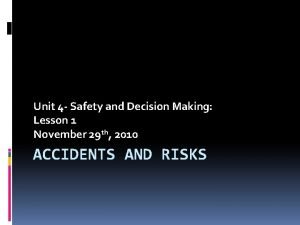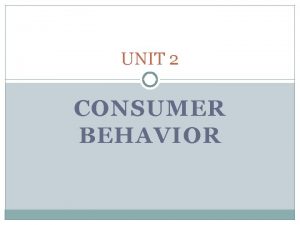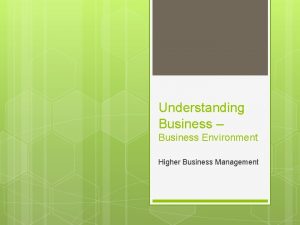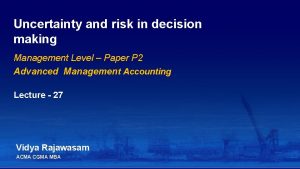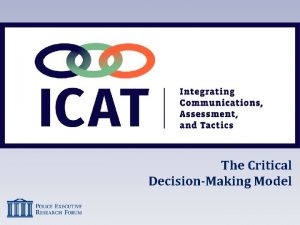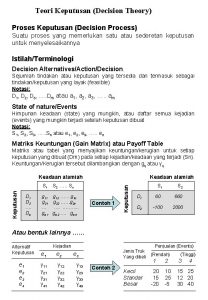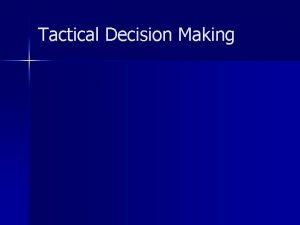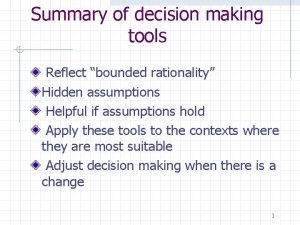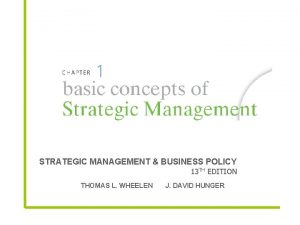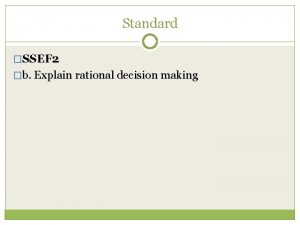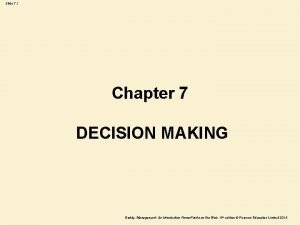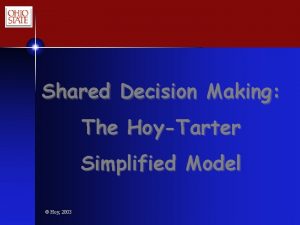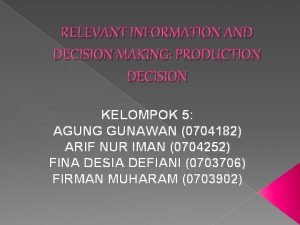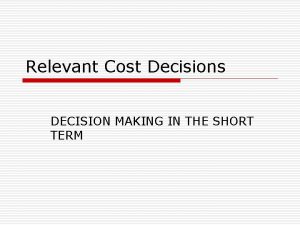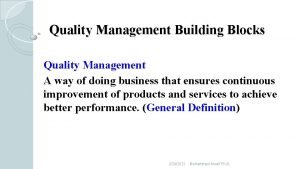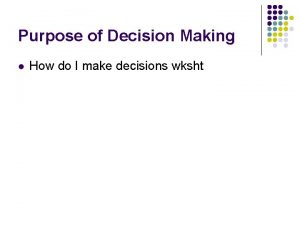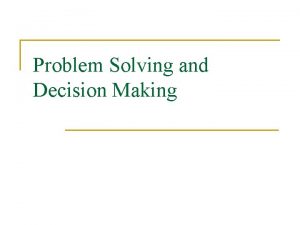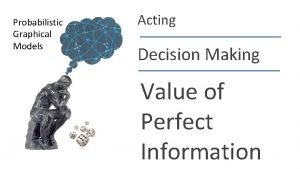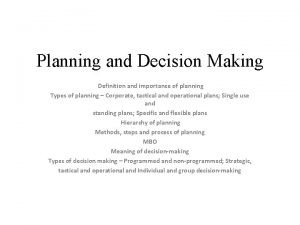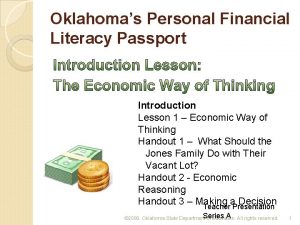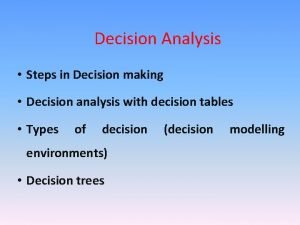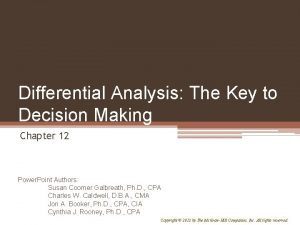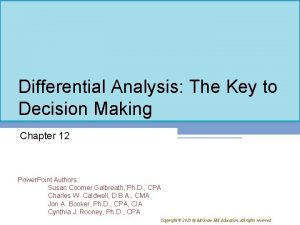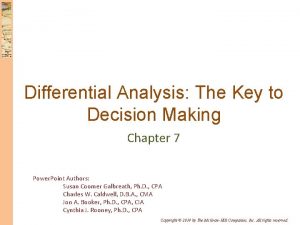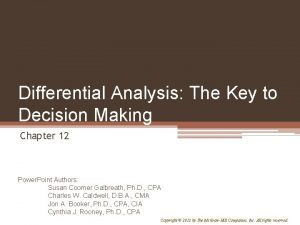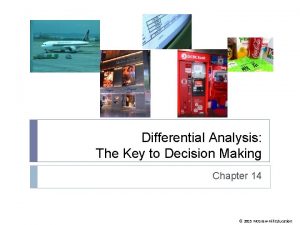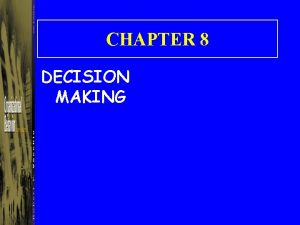Differential Analysis The Key to Decision Making Chapter

























































- Slides: 57

Differential Analysis: The Key to Decision Making Chapter 12 Nov 20, 2013 Power. Point Authors: Susan Coomer Galbreath, Ph. D. , CPA Charles W. Caldwell, D. B. A. , CMA Jon A. Booker, Ph. D. , CPA, CIA Cynthia J. Rooney, Ph. D. , CPA Copyright © 2012 by The Mc. Graw-Hill Companies, Inc. All rights reserved.

12 -2 Typical Management Decisions • • • What products to sell Whether to make or buy component parts What prices to charge Which channels of distribution to use Whether to accept special orders/prices Whether to keep or shut down an operation

12 -3 Making the right Decision • Every decision involves choosing from alternatives • Key is to which costs and benefits differ between the alternatives • Cost and benefits that differ between alternatives are Relevant and must be considered • Cost and benefits that remain the same are not relevant and can be ignored.

12 -4 Learning Objective 1 Identify relevant and irrelevant costs and benefits in a decision.

12 -5 Relevant Costs and Benefits A relevant cost is a cost that differs between alternatives. A relevant benefit is a benefit that differs between alternatives. 1 2

12 -6 Identifying Relevant Costs An avoidable cost is a cost that can be eliminated, in whole or in part, by choosing one alternative over another. Avoidable costs are relevant costs , i. e. , variable costs. Unavoidable costs are irrelevant costs, i. e. , fixed costs.

12 -7 Identifying Relevant Costs Two broad categories of costs are never relevant in any decision. They include: Sunk costs (money has already been spent) A future cost that does not differ between the alternatives

12 -8 Decision Making: A Two-Step Process Step 1 Eliminate costs and benefits that do not differ between alternatives. Step 2 Use the remaining costs and benefits that differ between alternatives in making the decision. The costs that remain are the differential, or avoidable, costs.

12 -9 Different Costs for Different Purposes Costs that are relevant in one decision situation may not be relevant in another context. Thus, in each decision situation, the manager must examine the data at hand isolate the relevant costs.

12 -10 Identifying Relevant Costs Cynthia, a Boston student, is considering visiting her friend in New York. She can drive or take the train. By car, it is 230 miles to her friend’s apartment. She is trying to decide which alternative is less expensive and has gathered the following information: $45 per month × 8 months $2. 70 per gallon ÷ 27 MPG $24, 000 cost – $10, 000 salvage value ÷ 5 years

12 -11 Identifying Relevant Costs

12 -12 Identifying Relevant Costs Which costs and benefits are relevant in Cynthia’s decision? The cost of the car is a sunk cost and is not relevant to the current decision. The annual cost of insurance is not relevant. It will remain the same if she drives or takes the train. However, the cost of gasoline is clearly relevant if she decides to drive. If she takes the train, the cost would not be incurred, so it varies depending on the decision.

12 -13 Identifying Relevant Costs Which costs and benefits are relevant in Cynthia’s decision? The cost of maintenance and repairs is relevant. In the long-run these costs depend upon miles driven. The monthly school parking fee is not relevant because it must be paid if Cynthia drives or takes the train. At this point, we can see that some of the average cost of $0. 619 per mile are relevant and others are not.

12 -14 Identifying Relevant Costs Which costs and benefits are relevant in Cynthia’s decision? The decline in resale value due to additional miles is a relevant cost. The round-trip train fare is clearly relevant. If she drives the cost can be avoided. Relaxing on the train is relevant even though it is difficult to assign a dollar value to the benefit. The kennel cost is not relevant because Cynthia will incur the cost if she drives or takes the train.

12 -15 Identifying Relevant Costs Which costs and benefits are relevant in Cynthia’s decision? The cost of parking in New York is relevant because it can be avoided if she takes the train. The benefits of having a car in New York and the problems of finding a parking space are both relevant but are difficult to assign a dollar amount.

12 -16 Identifying Relevant Costs From a financial standpoint, Cynthia would be better off taking the train to visit her friend. Some of the nonfinancial factors may influence her final decision.

12 -17 Total and Differential Cost Approaches The management of a company is considering a new labor saving machine that rents for $3, 000 per year. Data about the company’s annual sales and costs with and without the new machine are:

12 -18 Total and Differential Cost Approaches As you can see, the only costs that differ between the alternatives are the direct labor costs savings and the increase in fixed rental costs. We can efficiently analyze the decision by looking at the different costs and revenues and arrive at the same solution.

12 -19 Total and Differential Cost Approaches Using the differential approach is desirable for two reasons: 1. Only rarely will enough information be available to prepare detailed income statements for both alternatives. 2. Mingling irrelevant costs with relevant costs may cause confusion and distract attention away from the information that is really critical.

12 -20 Learning Objective 2 Prepare an analysis showing whether a product line or other business segment should be added or dropped.

12 -21 Adding/Dropping Segments One of the most important decisions managers make is whether to add or drop a business segment. Ultimately, a decision to drop an old segment or add a new one is going to hinge primarily on the impact the decision will have on net operating income. To assess this impact, it is necessary to carefully analyze the costs.

12 -22 Adding/Dropping Segments Due to the declining popularity of digital watches, Lovell Company’s digital watch line has not reported a profit for several years. Lovell is considering discontinuing this product line.

12 -23 A Contribution Margin Approach DECISION RULE Lovell should drop the digital watch segment only if its profit would increase. Lovell will compare the contribution margin that would be lost to the costs that would be avoided if the line was to be dropped.

12 -24 Adding/Dropping Segments

12 -25 Adding/Dropping Segments An investigation has revealed that the fixed general factory overhead and fixed general administrative expenses will not be affected by dropping the digital watch line. The fixed general factory overhead and general administrative expenses assigned to this product would be reallocated to other product lines.

12 -26 Adding/Dropping Segments The equipment used to manufacture digital watches has no resale value or alternative use. Should Lovell retain or drop the digital watch segment?

12 -27 A Contribution Margin Approach Re tai n

12 -28 Comparative Income Approach The Lovell solution can also be obtained by preparing comparative income statements showing results with and without the digital watch segment. Let’s look at this second approach.

12 -29 If the digital watch line is dropped, the company loses $300, 000 in contribution margin.

12 -30 On the other hand, the general factory overhead would be the same under both alternatives, so it is irrelevant.

12 -31 The salary of the product line manager would disappear, so it is relevant to the decision.

12 -32 The depreciation is a sunk cost. Also, remember that the equipment has no resale value or alternative use, so the equipment and the depreciation expense associated with it are irrelevant to the decision.

12 -33 The complete comparative income statements reveal that Lovell would earn $40, 000 of additional profit by retaining the digital watch line.

12 -34 Beware of Allocated Fixed Costs Why should we keep the digital watch segment when it’s showing a $100, 000 loss?

12 -35 Beware of Allocated Fixed Costs The answer lies in the way we allocate common fixed costs to our products.

12 -36 Beware of Allocated Fixed Costs Including unavoidable common fixed costs makes the product line appear to be unprofitable. Our allocations can make a segment look less profitable than it really is.

12 -37 Another Example: Dropping a Product line Review exhibits 12 -2, 12 -3, pages 535 – 537 Dangers of Allocated Fixed Costs: a better approach, see exhibit 12 -4

12 -38 Learning Objective 3 Prepare a make or buy analysis.

12 -39 The Make or Buy Decision When a company is involved in more than one activity in the entire value chain, it is vertically integrated. A decision to carry out one of the activities in the value chain internally, rather than to buy externally from a supplier is called a “make or buy” decision.

12 -40 Vertical Integration- Advantages Smoother flow of parts and materials Better quality control Realize profits

12 -41 Vertical Integration- Disadvantage Companies may fail to take advantage of suppliers who can create economies of scale advantage by pooling demand from numerous companies. While the economics of scale factor can be appealing, a company must be careful to retain control over activities that are essential to maintaining its competitive position.

12 -42 Vertical Integration - disadvantage • Using company resources to make internally, that could be used to make other, more profitable products • I. e. , you are making product A, which is profitable, but can make product B, which is more profitable.

12 -43 The Make or Buy Decision: An Example Essex Company manufactures part 4 A that is used in one of its products. The unit product cost of this part is:

12 -44 The Make or Buy Decision • The special equipment used to manufacture part 4 A has no resale value. • The total amount of general factory overhead, which is allocated on the basis of direct labor hours, would be unaffected by this decision. • The $30 unit product cost is based on 20, 000 parts produced each year. • An outside supplier has offered to provide the 20, 000 parts at a cost of $25 per part. Should we accept the supplier’s offer?

12 -45 The Make or Buy Decision The avoidable costs associated with making part 4 A include direct materials, direct labor, variable overhead, and the supervisor’s salary.

12 -46 The Make or Buy Decision The depreciation of the special equipment represents a sunk cost. The equipment has no resale value, thus its cost and associated depreciation are irrelevant to the decision.

12 -47 The Make or Buy Decision Not avoidable; irrelevant. If the product is dropped, it will be reallocated to other products.

12 -48 The Make or Buy Decision Should we make or buy part 4 A? Given that the total avoidable costs are less than the cost of buying the part, Essex should continue to make the part.

12 -49 Opportunity Cost/Benefit • Exhibit 12 -5, page 541 indicates that it would cost the company $40, 000 more to buy from an outside supplier rather than make it themselves • However, what if the company can utilize the space to make a new product that would generate additional product margin of $60, 000 (opportunity benefit) • It this case, company should buy from outside vendor, and make the new product

12 -50 Learning Objective 4 Prepare an analysis showing whether a special order should be accepted.

12 -51 Key Terms and Concepts A special order is a one-time order that is not considered part of the company’s normal ongoing business. When analyzing a special order, only the incremental costs and benefits are relevant. Since the existing fixed manufacturing overhead costs would not be affected by the order, they are not relevant.

12 -52 Special Orders Ø Jet, Inc. makes a single product whose normal selling price is $20 per unit. Ø A foreign distributor offers to purchase 3, 000 units for $10 per unit. Ø This is a one-time order that would not affect the company’s regular business. Ø Annual capacity is 10, 000 units, but Jet, Inc. is currently producing and selling only 5, 000 units. Should Jet accept the offer?

12 -53 Special Orders $8 variable cost

12 -54 Special Orders If Jet accepts the special order, the incremental revenue will exceed the incremental costs. In other words, net operating income will increase by $6, 000. This suggests that Jet should accept the order. Note: This answer assumes that the fixed costs are unavoidable and that variable marketing costs must be incurred on the special order.

12 -55 Quick Check Northern Optical ordinarily sells the X-lens for $50. The variable production cost is $10, the fixed production cost is $18 per unit, and the variable selling cost is $1. A customer has requested a special order for 10, 000 units of the X-lens to be imprinted with the customer’s logo. This special order would not involve any selling costs, but Northern Optical would have to purchase an imprinting machine for $50, 000. (see the next page)

12 -56 Quick Check What is the rock bottom minimum price below which Northern Optical should not go in its negotiations with the customer? In other words, below what price would Northern Optical actually be losing money on the sale? There is ample idle capacity to fulfill the order and the imprinting machine has no further use after this order. a. $50 b. $10 c. $15 d. $29

12 -57 Quick Check What is the rock bottom minimum price below which Northern Optical should not go in its negotiations with the customer? In other words, below what price would Northern Optical actually be losing money on the sale? There is ample idle capacity to fulfill the order and the imprinting machine has no further after this Variable production costuse$100, 000 order. Additional fixed cost + 50, 000 $150, 000 a. $50 Total relevant cost 10, 000 b. $10 Number of units Average cost per unit= $15 c. $15 d. $29
 Differential analysis: the key to decision making
Differential analysis: the key to decision making Differential analysis the key to decision making
Differential analysis the key to decision making Chapter 2 economic systems and decision making answer key
Chapter 2 economic systems and decision making answer key Chapter 2 economic systems and decision making
Chapter 2 economic systems and decision making No decision snap decision responsible decision
No decision snap decision responsible decision Slidetodoc.com
Slidetodoc.com Swot analysis decision making
Swot analysis decision making Contribution analysis in decision making
Contribution analysis in decision making Chapter 6 prices and decision making assessment answers
Chapter 6 prices and decision making assessment answers Steps in decision making
Steps in decision making Management chapter 5 planning and decision making
Management chapter 5 planning and decision making Financial decision making process
Financial decision making process Chapter 2 economic systems and decision making
Chapter 2 economic systems and decision making Copyright
Copyright Relevant cost for decision making solution chapter 13
Relevant cost for decision making solution chapter 13 Chapter 11 decision making and relevant information
Chapter 11 decision making and relevant information Chapter 2 management supervision and decision making
Chapter 2 management supervision and decision making Decision making and relevant information
Decision making and relevant information Management chapter 5 planning and decision making
Management chapter 5 planning and decision making Chapter 1 section 3 economic choices and decision making
Chapter 1 section 3 economic choices and decision making Chapter 14 the human genome making karyotypes answer key
Chapter 14 the human genome making karyotypes answer key Decision tree and decision table
Decision tree and decision table Youth involvement
Youth involvement Ethical assessment screen
Ethical assessment screen Systematic decision making process
Systematic decision making process What doing our country
What doing our country Mamdm
Mamdm Using recursion in models and decision making sheet 3
Using recursion in models and decision making sheet 3 Paced decision making
Paced decision making Unit 4 lesson 1 decision making
Unit 4 lesson 1 decision making Decision making to improve marketing performance
Decision making to improve marketing performance Types of decision making
Types of decision making Higher business management
Higher business management Decision making unit example
Decision making unit example Types of decision making
Types of decision making The role of marketing research
The role of marketing research Perf critical decision making model
Perf critical decision making model Contoh soal decision tree
Contoh soal decision tree Tactical decision making
Tactical decision making What is the dare decision making model
What is the dare decision making model Rational decision making model
Rational decision making model Mintzberg's modes of strategic decision making
Mintzberg's modes of strategic decision making Paced decision making
Paced decision making Decision making conditions
Decision making conditions Sbdm roles and responsibilities
Sbdm roles and responsibilities Model hoy
Model hoy Decision making and relevant information
Decision making and relevant information Decision making and relevant information
Decision making and relevant information Building blocks of quality
Building blocks of quality Abcde decision making model
Abcde decision making model Problem space in psychology
Problem space in psychology Best books on problem solving and decision making
Best books on problem solving and decision making Individual and group decision making
Individual and group decision making What graphical model is appropriate for decision making
What graphical model is appropriate for decision making Individual and group decision making
Individual and group decision making Habitual decision making adalah
Habitual decision making adalah Paced decision model
Paced decision model What is the paced decision making model
What is the paced decision making model
